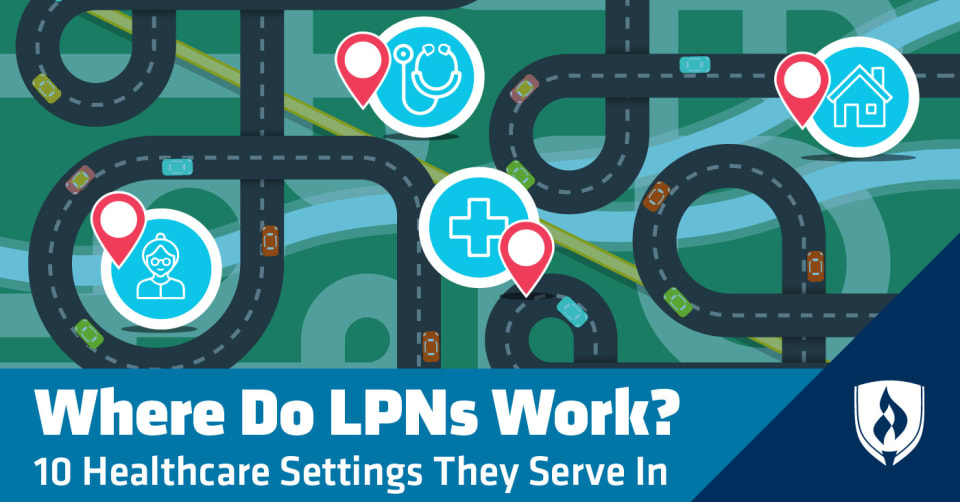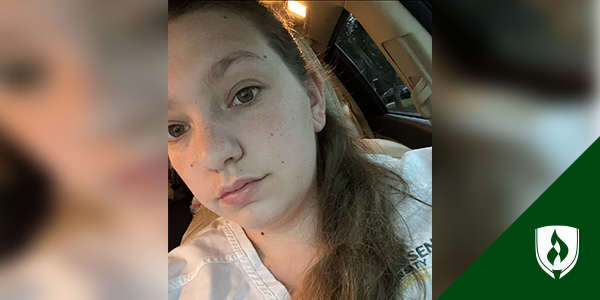
Nurses are an integral part of our healthcare system—and that rings true for licensed practical nurses (LPNs). While your mind might immediately jump to a busy hospital when imagining where nurses work, LPNs actually have the opportunity to apply their skills in a wide variety of work environments. In this article we’ll highlight the common duties of an LPN and explore some of the lesser-known locations you may find them working in.
Get Your Nursing School Questions Answered at a Nursing Information Session
What is an LPN?
Registered nurses, nurse practitioners, and licensed practical nurses all practice nursing, but each have distinct educational and licensing requirements which authorize them for separate scopes of practice.
While it can take years to become nurse practitioner or a registered nurse, becoming a licensed practical nurse (LPN) requires completing a program that can be completed in as few as 12 months.1 LPNs must complete an approved program which combines supervised clinical experience with classes on nursing, biology and pharmacology. After completing the program, prospective LPNs take the National Council Licensure Examination-Practical Nursing (NCLEX-PN) exam.
What do LPNs do?
It’s important to note that depending on state regulations, LPNs may perform slightly different tasks—for example, giving medication or intravenous drips. Aside from these state-level differences in scope of practice, common LPN tasks will include:
- Monitoring patient health
- Changing bandages
- Inserting catheters
- Helping patients bathe or dress
- Discussing care with patients
- Reporting patients’ status and concerns to RNs or physicians
- Keeping records of patient health
According to the Bureau of Labor and Statistics important qualities for an LPN include compassion, attention to detail, interpersonal skills, patience, physical stamina and speaking skills.2
Where do LPNs work? 10 Options you might not know about
Now that you’re a bit more familiar with the types of duties LPNs perform, let’s take a closer look at the types of facilities in which these nurses provide care.
1. Nursing homes and residential care facilities
With an aging baby boom population, nursing homes are a common landing spot for LPNs. The majority of nursing home residents are over the age of 65, but individuals with serious long-term ailments may also need care in these facilities. The essential role of a nursing home is to provide a living situation for individuals who have too many medical needs to live at home, and too few to require hospitalization.
LPNs work alongside healthcare and administrative professionals to address the needs of nursing home residents. LPNs within a nursing home are closely involved with the case management of residents, which offers unique challenges and rewards.
2. Hospitals
Hospitals are another fairly-common work setting for LPNs. 15 percent of LPNs are employed in hospitals, according to the BLS, making them the second most common work environments for LPNs after nursing and residential care facilities.2
Hospitals are the site of the most intensive healthcare interventions. LPNs employed within hospitals work closely with doctors and other members of a patient’s care team, typically assisting with lower-level patient care work.
3. Physicians’ offices
Another option for LPNs that shouldn’t come as a surprise is working at a physicians’ office. Working within a doctor’s office may offer a slower pace than employment within a hospital setting, but there’s still plenty to get done. The type of work done by LPNs in doctors’ offices can vary somewhat based on the type of medicine practiced within them—an LPN may help check patients in, gather information about symptoms or ailments and administer shots or other medications as needed.
4. Rehab facilities
Rehabilitation facilities offer temporary residence to patients during periods of transition. These patients are preparing for more independent living situations through physical therapy, occupational therapy and medical treatment. Rehabilitation facilities can be challenging for healthcare providers and for patients, but allow individuals to meet important and meaningful goals.
5. Home health care
Home health care is a rapidly growing area of healthcare. With an aging population increasingly choosing to live at home, home health care provides important medical, therapeutic, and personal services that can dramatically improve a patient’s quality of life. Working within a patient’s home establishes a unique relationship of trust between patient and healthcare provider.
6. Outpatient surgery center
Outpatient surgery centers perform surgical procedures that do not require patients to stay overnight in a hospital.
Outpatient surgery centers are able to provide services at lower costs than inpatient procedures, often with benefits to a patient’s quality of care as they are able to recover primarily at home. Medical advancements are allowing more complex surgeries to be safely performed in an outpatient setting, making outpatient surgery centers a growing employer of LPNs.
7. Immunization clinic
Many LPNs are employed in immunization clinics either full time or on a seasonal basis. Immunization clinics provide essential care without requiring individuals to travel to doctor’s offices or hospitals. Often, immunization clinics are able to reach underserved communities such as people in rural areas or individuals who are unable to travel to larger healthcare centers.
8. Schools
We’ve all been there—hunkering down in the school nurse’s office, ice pack in hand or guts spinning with nausea. While those experiences might not have always been fun, it’s easy to appreciate the work of a school nurse. Though many states require school nurses to be RNs, some LPNs are employed within school settings. As a school nurse, an LPN provides basic healthcare services to students and faculty as needed. LPNs are sometimes able to work as a school nurse under the supervision an offsite RN in some areas.
9. Medical / clinical call centers
While not a common landing spot, the growth of telehealth initiatives has opened the door for medical professionals to work within a clinical call center environment. Medical call centers take after hour calls to healthcare providers. LPNs are valuable employees at medical call centers due to their experience and knowledge of healthcare. Employees at a medical call center field patient questions, relay important information to care teams, or direct callers to the necessary emergency services.
10. Insurance companies
Insurance companies frequently employ LPNs and other healthcare professionals in order to accurately process claims. Working for an insurance company strengthens an LPN’s administrative skills and does not require direct patient care necessary for an LPN working in a nursing home or hospital setting.
Where do you envision yourself working as an LPN?
As an LPN, there are many ways to put your valuable knowledge and skills to work. If you are interested in working directly with patients improving quality of life, a position in home health care might be good fit. If you are more interested in the administrative side of healthcare, work at a medical call center might suit you better. No matter where you land, it’s important to know that you’ll be part of a larger healthcare team whose work helps patients on a daily basis.
If you’d like to get started on the road to becoming an LPN, check out our article, “How to Become an LPN: 5 Steps to Earning Your Scrubs.”
1Completion time is dependent on the number of transfer credits accepted and the number of courses completed each term.
2Bureau of Labor Statistics, U.S. Department of Labor, Occupational Outlook Handbook, [accessed March, 2020] www.bls.gov/ooh/. Information represents national, averaged data for the occupations listed and includes workers at all levels of education and experience. This data does not represent starting salaries. Employment conditions in your area may vary.




